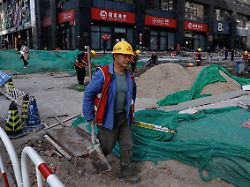Powered by new factories
China’s economy is growing faster than expected
April 16, 2024, 6:50 a.m
The Chinese government has been trying for months to stimulate economic growth with targeted measures. Beijing is resorting to a well-known tactic that neglects a struggling economic sector.
The Chinese economy grew significantly more than expected in the first quarter. The gross domestic product (GDP) increased by 5.3 percent from January to March compared to the same period last year, as the statistics office in Beijing announced. Economists surveyed by the Reuters news agency, however, had expected an increase of 4.6 percent.
This is a welcome sign for the government of the second largest economy after the USA. It has long been trying to boost demand and confidence in the face of an ongoing real estate crisis. Compared to the previous quarter, GDP grew by 1.6 percent from January to March. This is above analysts’ expectations of plus 1.4 percent and above the increase in the previous quarter of a revised 1.2 percent.
The government is aiming for economic growth of around 5.0 percent for the year as a whole. Many analysts consider this target ambitious and estimate that further incentives may be necessary. The economy is recovering only with difficulty after the massive restrictions caused by the corona pandemic. In addition, it is not only the real estate crisis that is weighing on it, but also the shrinking population.
To counteract this and stimulate growth, China had resorted to a familiar tactic: It invested heavily in its manufacturing sector, building numerous factories that helped boost global sales of solar cells, electric cars and other products.
The move was received less positively internationally. At the beginning of April, the rating agency Fitch downgraded the outlook for the development of China’s creditworthiness. She cited “growing risks to China’s public finances” due to the more uncertain economic outlook. Beijing is channeling more spending into infrastructure and high-tech production while at the same time turning away from the real estate sector.
